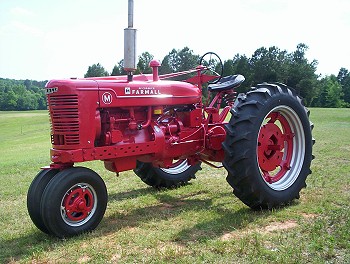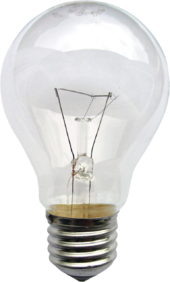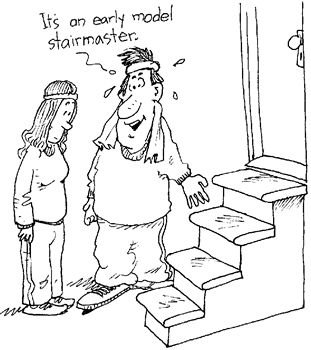Ok, if you’re tired of being lectured about your sweet tooth or laziness (or both), and just want the straight dope from an engineer, you’ve come to the right place.
 You see, over the next couple of minutes, we’ll see that a human body is not much different to, say, a tractor. It’s a tough machine and just like a tractor has very few needs – a little fuel, a little air and a little water.
You see, over the next couple of minutes, we’ll see that a human body is not much different to, say, a tractor. It’s a tough machine and just like a tractor has very few needs – a little fuel, a little air and a little water.
Ok, ok, we’re a little more complex, but when push comes to shove, we are pretty similar, let me show you…
Food = Fuel
My wife despairs, but she I must point out that she chose to marry an engineer with hardly any niceties. Yes, ok, food is more than just fuel, it’s one of the joys of life yadda-yadda, but, to the engineer in me food is just a handy combination of energy and building materials.
The human is a machine – a beautiful, self-building, self-replicating, self-repairing, self-aware machine, but a machine nonetheless.
Fat is Energy!
The next thing to understand is that fat is energy, indeed to the engineer a lump of lard is literally lightning in a jar – it turns out fat is evolution’s answer to the battery.
Of course, because evolution is not as clever as us, I’m sure you’d expect it’s not a great battery, but you’d be wrong. On a weight-for-weight basis, fat packs in around 50 times more energy than a rechargeable lithium-ion type in your laptop. Good job evolution!
And yes, that does mean it’s technically correct for larger folks to claim to be more energetic.
Burn baby burn!
Fad diets come and go, but only one truth has been proven – eat less – or burn more.
 And I do mean burn. Any diet that claims to ‘dissolve’ away fat is misleading you with comforting words. It turns out there are literally only two decent ways to remove fat: by liposuction – or by actually burning it. Yes, the only decent way the body can excrete the carbon in your love-handles is as exhaled CO2, and the only way to turn fat into CO2 is by little baby fires. So yes, burning fat faster means getting hotter, and breathing harder.
And I do mean burn. Any diet that claims to ‘dissolve’ away fat is misleading you with comforting words. It turns out there are literally only two decent ways to remove fat: by liposuction – or by actually burning it. Yes, the only decent way the body can excrete the carbon in your love-handles is as exhaled CO2, and the only way to turn fat into CO2 is by little baby fires. So yes, burning fat faster means getting hotter, and breathing harder.
Luckily we have these fires burning all the time, so we don’t actually need to exercise, and we can get through around 100 Calories an hour just sitting around reading blogs. Going for a run simply increases that rate.
Now let’s look at the whole deal as engineers and see what we learn!
To engineers, the ‘rate’ at which we burn energy is not our ‘metabolism’, it’s our power! And just like an electric motor or stereo loudspeaker, our power output can be measured in watts.
Let’s take a quick look at the power ratings of some of the things around us to get some context.
 The golden standard reference for power is generally the light bulb. The common light-bulb we all know and love is most usually 60 watts (though times they are a changin’). A TV may be 100-300W depending on size, a microwave oven 800W, a vacuum cleaner 1200W and an kettle or oven around 2kW (2000W). A small car packs around 60kW (a thousand light bulbs!) while a nice all-american truck such as the Ford F450 packs around 300kW, although not all the time of course.
The golden standard reference for power is generally the light bulb. The common light-bulb we all know and love is most usually 60 watts (though times they are a changin’). A TV may be 100-300W depending on size, a microwave oven 800W, a vacuum cleaner 1200W and an kettle or oven around 2kW (2000W). A small car packs around 60kW (a thousand light bulbs!) while a nice all-american truck such as the Ford F450 packs around 300kW, although not all the time of course.
So what about the human body.? Well it consumes around 2000-2500 Calories per day.
A consumption rate of 2500 Calories (for the average male) turns to just over 10,000 kJ a day, which converts to a mean power of around 120 joules each second, or 120 watts.
So you are like two light bulbs. Or a mid sized TV, or a PC.
 Of course sometimes we sit about and other times we heroically ride a stairmaster, how much does our energy consumption vary?
Of course sometimes we sit about and other times we heroically ride a stairmaster, how much does our energy consumption vary?
Well, unlike a car, we can’t turn off our engines when we’re parked in the garage; we need to keep the engine turning over (to prevent the hard drive/brain from being erased). And our idle is set pretty high, indeed we consume rather a lot of power when doing nothing at all. It’s called the ‘basal metabolic rate‘, and seems to be about 70 watts on average but varies strongly with your size, specifically your weight without fat.
When we walk about, we consume well over 100W and we can of course exert much more power for short burst – a quick flight of stairs can require over 500 watts of output.
Of course we cannot keep up 500W; the best way to see what pro-athletes can do is in the world of cycling – they have bikes that can measure work via the torque applied to a pedal [4].
These folks can maintain over 400 watts for 5 minutes and averaged well over 200W for several hours – they are however not your average folk. If you try walking up a long staircase you’ll soon find the average person can really only deliver around 100W for any decent period, and that of course is over and above the 70W that just keeps you alive.
Now on to efficiency!
Ok, so if humans are machines, are they any good?
Again, let’s get some context from the world of machines. Much of our energy comes from burning fossil fuels – coal, for example, contains a lot of energy, but sadly, when we turn it into electricity via our usual methods we only capture only about a third of it [1]. We then lose another 6-8% of that energy in the wires. Then when we use that electricity to run a regular incandescent light bulb, we convert only about one fiftieth of that energy into light, overall less than 1% of the coal’s original energy. So it’s not surprising the EU has banned incandescent bulbs!
So what about cars? Well a regular car is only around 17-21% efficient at turning the energy in petrol into work [2]; Electric cars on the other hand are around 60% efficient [2], which sounds great, except of course you have to remember that the electricity itself may have been derived by burning stuff at around 30% efficiency, which takes you right back to around 20% from coal to the wheel.
You can estimate Calories using some simple rules. Basically, we start by imagining the food item was dried out because we can’t get energy from water; then figure out the proportion of oils/fats/sugars & proteins – that’ll be 9 Calories per gram for oils and fats – and 4 Cal/g for sugars, carbs and proteins – any roughage remaining gets a free pass [5].
So for example, a banana weighs 200g, but about three quarters water, so we have 50g, some of its fibre so lets say 45g is left; its around half sugar half carbs, so contributes 45×4=190 Calories.
How about a steak? Well it depends on the fat content – a ‘lean’ steak has less fat (obviously) but alas, unless you make it smaller, that volume is generally taken up with protein. Luckily protein has less than half the calories of fat so it does make a difference. Ok; so lets look at a 200g steak – it’s around 40-50% water once cooked; so we have 100-120g of fat and protein; a lean steak (like a top sirloin) will have a 1:5 fat:protein ratio, this gives you 20g fat & 100g protein – 20×9+100×4 =580 Calories. However a juicier cut (yes that juice ain’t water) such as a rib-eye can be 50:50 fat:protein, giving you 60g of each: 60*9+60*4=780 Calories. So lean is good, but let’s face it, fat tastes good and ultimately it’s the size of the steak that matter most. Speaking as a steak lover I have to say a small perfect steak is better than a big lean one.
Anyway, the idea holds for drinks too – but now you have to know that alcohol is nearly as Calorific as fat at 7 Calories/gram. Most sodas and fruit juices are around 10% by weight ‘non-water’, so for a 340ml (12floz) can, we get about 35g of mainly carbs or 140 Calories.
Beer is around 6-9% loading level, but in the case of beer around half of that is alcohol, so again we’re in at around 120-140 Calories for a can or bottle. You have to watch out though, when beverage container report % alcohol they report by volume (ABV = alcohol by volume), and because alcohol is lighter than water, the actual mass of alcohol you need to calculate calories is happily somewhat lower.
Wine is loaded a little more, around 12-14% and most of that is alcohol, so you get your 110-130 Calories in a piddly little 175ml glass. Boo!
A key concept in human efficiency is our metabolism. Diet gurus like to talk about metabolism – let’s shed a little light on that. Metabolism is the system of chemical ‘processes’ our food undergoes before delivering either new structure (for eg new bone) or useful ‘work’.
It is super-complex, and plenty of the jobs done are simply ‘support’ functions for other jobs – like when a muscle exerts force to lift a weight, there is also work to be done sending signals and pumping blood. Indeed some energy is used by the little creatures that live in our tummies. Similarly it takes quite a lot of energy to convert the food you like into the food your muscles like. Each step in the metabolism involves the flow of energy and there is often heat given off in the process.
Because of all the support functions, and our need to keep warm, not to mention our the idle time (rest) we are also pretty inefficient. The exact efficiency depends on your level of fitness – and on the job you are doing.
We are super efficient at warming air up a little (pretty darn close to 100%) but we are hopelessly inefficient at producing sound – and don’t even talk about light. So to be fair, lets consider our ability to exert force (lift weights and similar).
So scientists have been able to not only measure work output (via bicycle type gadgets) but also energy use – by measuring oxygen use or carbon dioxide generation. Based on this, they reckon we’re about 18-26% efficient.
This means that when we do run up stairs, we actually burn 4-5 times the energy required to do so – more good news for dieters!
Of course, because we need to rest so much, and eat and wash our faces and things, as machines, I reckon we’re probably well below 10% efficient at physical work and probably only a fraction of a % for office work. Frankly, it’ll come as no surprise to me when robots take over the planet.
Thermodynamics 101
Thermodynamics is often trucked out when a scientist wants to end a discussion – or to simply baffle people, but really there’s only one thing you need to know from this entire field of study: energy never vanishes!
That’s it. Once you have some energy, it turns out it cannot be gotten rid of. All you can hope for it to move it around or spread it about. That means that every Calorie you eat HAS TO GO SOMEWHERE; some will pass though you (think of poorly chewed sweetcorn), and some will do work (lifting your pint glass is important work). All the rest will go into heat – or storage.
That’s it. You now know more about Thermodynamics than 95% of the world, well done.
So armed with this knowledge we can can look at a few things, see they all add up.
Firstly, you’ll note when you exercise you breathe harder. Indeed your energy consumption and thus weight loss is directly and perfectly related to breathing – because you breath in to get some oxygen to fuel all the little fires. So exercise that makes you breathe harder is consuming energy. Alas, the fires do not always burn that annoying belly fat, but even if they consume some freshly eaten calories, at least they’ve intercepted them before they find safe haven somewhere unsightly.
Next we can also show that our rate of energy usage relates almost perfectly with the heat we give off. This is good and confirms that we don’t actually need to exercise to burn calories (yay!), indeed it turns out that our metabolism and basal metabolic rate link pretty perfectly with the heat we emit at rest.
This reasoning also explains why we get hot when we exercise – we are literally burning the fat and the heat has to go somewhere. As muscles are so inefficient, 80% of the energy they use turns to heat, not work, and we have to shed that heat. Some of the heat goes out with the heavy breathing, and the rest goes out the skin – with the help of a little sweat.
It also means that our modern life in nice snug centrally heated houses makes it harder to stay trim. Someone did the sums and reckons you can burn a chocolate bar every night by just keeping your room cool and getting used to a thinner blanket. Not sure being permanently chilly sounds like a good plan to me though!
Conclusion
So what help is all that? Well it gets right to the heart of the engineer’s approach to diet: you have to match your energy input to your energy output. There is no escape. You have to burn that fat, there is no other way about it. Sorry for the bad news!
And there is good news too. You can work it off. Anyone who says ‘exercise doesn’t work for me’ is conveniently deluding themselves – it always works, its the law of thermodynamics.
Take care now!
References…
[1] http://www.eia.gov/tools/faqs/faq.cfm?id=107&t=3
[2] http://www.fueleconomy.gov/feg/evtech.shtml
[3] http://en.wikipedia.org/wiki/Basal_metabolic_rate
[4] http://cyclingtips.com.au/2009/07/just-how-good-are-these-guys/
[5] http://www.caloriesperhour.com/tutorial_gram.php
Also interesting: What is the MPG of a human?
Cornell professor Dr. Brian Wansink said that when people ask him about how to lose weight, he counters with a series of questions. “The most important thing you want to figure out is whether somebody really wants to lose weight,” he said. He explained that people might think they want to slim down, but when they actually reflect on the sacrifices and commitment required — realize they aren’t ready.